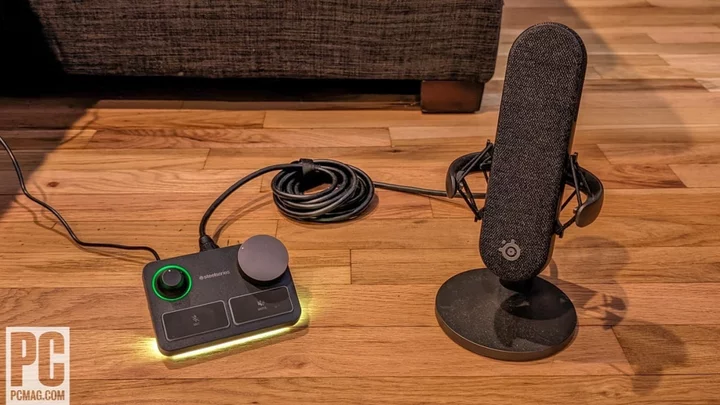When it comes to microphones, XLR mics are generally considered to be much more complicated than simple plug-and-play USB mics. They can offer richer and more detailed sound with a completely untouched signal to work with, but you need to worry about a mixer and things like phantom power so the setup process requires more effort and planning. SteelSeries’ Alias Pro simplifies that setup by including the XLR microphone and a single-port mixer in the box, with both components designed to work seamlessly together while powerful software lets you tweak the sound to your heart’s content. At $329.99, it’s more expensive than most USB mics we favor like the all-in-one Sennheiser Profile Streaming Set ($199), but its accessibility, signal flexibility, and excellent audio quality all justify the price and earn the Alias Pro our Editors’ Choice award.
Microphone: No Lights or Knobs, Just XLR
The Alias Pro package consists of two components: the microphone itself and the mixer. The microphone is a 7.4-by-2.1-by-1.7-inch (HWD) pill-shaped enclosure with a matte black plastic body and a flat front covered in black grille cloth. More cloth runs along the top and sides in thin bands, and a large section on the back. This is an XLR mic, so it only has an XLR connection for the included cable on the back side, near the bottom. Unlike the USB Alias, there are no controls and no RGB lighting on this model. XLR is all about audio quality, not flashiness, and the mic doesn’t support lighting or signals beyond the sounds the capsule picks up.
(Credit: Will Greenwald)The microphone uses a 25mm condenser capsule in a cardioid configuration for unidirectional recording. It samples at 24-bit and 48kHz, has a frequency response of 50Hz to 20kHz, and a maximum SPL of 120dB.
A circular table stand made of dark gray metal is included to hold up the mic. The stand includes an adjustable hinge for pivoting up and down, and a built-in shock mount that suspends the mic in its ring-shaped arm. The microphone can alternatively attach to an included boom arm adapter that supports both 3/8- and 5/8-inch threads.
Mixer: Buttons, Dials, and Ports
The other half of the Alias Pro is the XLR mixer, a vital component for connecting the microphone to your computer. It measures 4.4 by 2.0 by 3.2 inches and features a triangular profile that angles the mixer’s face toward you. The mixer is very simple, with a large multi-purpose dial on the top right, a smaller gain knob surrounded by a status ring light on the top left, and two flat rectangular buttons below them for muting the microphone and the connected headphones or speakers. The mute buttons glow and have customizable RGB lighting, and a separate light bar is hidden under the front lip for more programmable ambience.
(Credit: Will Greenwald)In addition to the XLR input, the back of the mixer holds a connector for the power adapter, two USB-C ports for connecting to up to two computers (this is helpful if you have a streaming PC and a separate computer to run PC games), a 3.5mm line out port, a power button, and a status LED for +48W phantom power. A headphone jack sits on the left side. The mixer provides +48V of phantom power, which you can optionally turn off in the configuration software. There’s no reason to disable it, however, since the mic requires phantom power to work, and neither the mic nor the mixer are currently sold as separate products. As a limitation, there's only one XLR input, so the mixer can't grow with you if you want to expand your recording setup to support multiple microphones.
The headphone jack is great for having a consistent wired audio output you can precisely control with the mixer and software, but be aware that it’s only an output and not an amp. This won’t be a problem for most lightweight wired headphones with fairly low impedance, but audiophile headphones with higher impedance will sound a bit soft. While listening with Sennheiser HD 58X headphones through the mixer, audio sounded very clear but not particularly loud even at maximum volume. The HD 58X headphones have an impedance of 150 Ohms whereas most wired headphones hovers around 32 Ohms, so unless you’re a headphone enthusiast this likely won’t come up.
Software: Sonar Does It All
SteelSeries’ GG software for Mac and Windows provides some of the most powerful audio configurations we’ve seen in any app from a gaming brand. The Sonar section in GG provides extensive customization options, including parametric equalizers for aux, chat, game, media, and mic audio. You can spend time tweaking every curve to refine what you hear and what you sound like with the EQ, or choose from a selection of presets for each one. The Mic tab lets you toggle several additional features, including Clearcast AI noise cancellation, background and impact noise reduction sliders if you don’t want to use Clearcast (for distant, droning sounds like fans and closer, punchy sounds like keyboards), a compressor, and a noise gate. The Game tab also enables spatial audio through any wired headphones connected to the mixer.
(Credit: SteelSeries)Sonar features a mixer for aux, chat, game, media, and mic sources by default, but it really adds power when you switch to Streamer Mode. This mode splits each source into personal and stream mixes with individual level sliders for each device, so you can tweak what you hear separately from what your stream hears. With the software mixer properly adjusted, you can then set up the personal mix to go to your headphones and have the stream mix go to Streamlabs, OBS, or any other streaming or recording software.
The Engine tab treats the mixer as its own device, and lets you program what the non-gain dial and the non-mic mute button control. They default to the headphone output, but they can mute and adjust the personal or stream levels of the aux, chat, game, master, media, or mic signals.
Engine also lets you adjust the lighting on the mute buttons and the mixer’s light bar, though these options are oddly under different menus. The mute button settings reside in the device menu, but the light bar must be configured under the Prism tab. Prism is an early access feature for programming RGB lighting on SteelSeries products, offering a variety of customizable effects similar to Razer’s Chroma software for its devices. The light bar can cycle through different colors or even reflect whatever color is prominent on a section of your screen, while the buttons are limited to a single color for both.
Clear, Adjustable Sound
The mic, piped through the mixer with Sonar features enabled, sounds excellent. Test recordings of my voice sound full, detailed, and clear enough for streaming or recording podcasts. The Clearcast AI Noise Cancellation, aided by the simple unidirectional nature of a cardioid capsule, blocked out nearby fan, dishwasher, and keyboard noise without changing how my voice sounded.
(Credit: Will Greenwald)Default settings with the Alias Pro Desk Stand EQ preset sounded very good, but my voice lacked some of the crisper edge better USB mics I’ve tested offer. Switching to the Balanced EQ preset, which pushes frequencies between 1kHz and 10kHz higher than the other setting, quickly cleared things up. Suddenly my voice sounded clean and natural, as if I was listening to myself in the same room rather than listening to a recording.
Since everyone’s voice and speech style are different, Sonar's extensive options are useful to have. If you can’t find a preset that works for you, the parametric equalizer will let you create a custom curve for how you talk and where your mic is located. Lag-free listening to the mic feed through the mixer, combined with the gain knob, makes it quick and easy to check that you sound just as you should and weed out any kinks for streams or recordings. And because it’s an XLR microphone going through a mixer, the signal itself begins completely untouched and is not subject to any mic-bound digital signal processing (DSP), a limitation of many USB mics.
I have no musical ability myself, and serious musicians will probably want a more purpose-built recording setup than a mic paired with a single-port mixer that's designed primarily for streaming. The signal quality is there to work with, though, and it's at least comparable with similarly priced cardioid XLR microphones for home studios. A music test recording sounded about as rich and crisp captured through the mic as it did in real life, so while the Alias Pro is intended mostly for streamers, it can be used for musical projects in a pinch (recording one track at a time, of course).
Easy XLR Audio for Everyone
The SteelSeries Alias Pro is a fantastic microphone for serious content creators who want the clean, full signal XLR can provide with the relative ease of a USB microphone. The XLR mixer and SteelSeries’ software enable clear recordings with a few clicks, while the signal chain and tools give you the flexibility to truly refine how you sound. It’s a powerful one-mic toolkit that cuts back the learning curve and space requirements of building your own mixer setup, earning the Alias Pro our Editors' Choice award. That said, an XLR solution isn’t essential for single-mic recording or streaming, and you can get clear sound, a transparent signal, and a boom arm for about $130 less with the Sennheiser Profile Streaming Set, our Editors' Choice for USB microphones. Meanwhile, the Rode NT1 5th Generation ($259) is a compelling alternative if you plan to upgrade to XLR in the future as it features both USB and XLR connections, along with up to 192kHz, 32-bit sampling.









